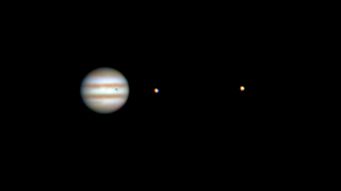
This CCD image shows the shadow of Jupiter's moon Europa crossing the face of the planet. The moon's shadow is visible as the dark spot to the right of center on the face of Jupiter. In this image, Europa is to the closest moon to the right of the planet. The moon to the far right is Io.
Jupiter is a giant planet that is easily visible to the naked eye as a very bright "star" that outshines all of the stars and all of the other planets except Venus. Jupiter was named for the mythological Roman king of the gods and ruler of the universe. When Galileo invented the first crude telescope, Jupiter was one of the first objects that he observed. Galileo shook the then prevailing belief-system that everything revolved around the Earth when he reported his observations of four bright moons orbiting Jupiter. As a result, Galileo was persecuted by the church, and forced to recant. Between 1995 and 2003, a spacecraft orbited Jupiter bearing Galileo's name, and returned stunning images of Jupiter and its moons to scientists on Earth.
The photo is a composite RGB CCD image taken at prime focus with a Takahashi Mewlon 210 telescope (the scope has a Dall-Kirkham design) using an SBIG ST-8E CCD. This image was taken from my backyard in Scottsdale, Arizona.
Constellation: Cancer
RA: 08h 49m 56.6s Dec: +18d 35' 46"
May 8, 2003 at 0530 U.T.
Image by Sid Leach
Scottsdale, Arizona
Recent Images.
Complete list of images.
Description of equipment used to acquire images.
Home
Feedback and comments should go to Sid